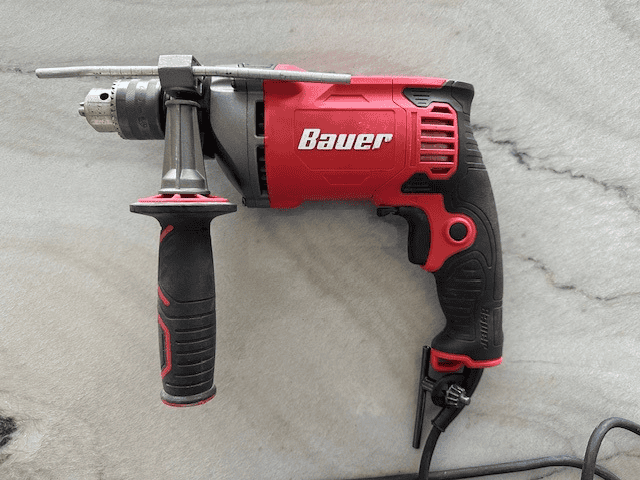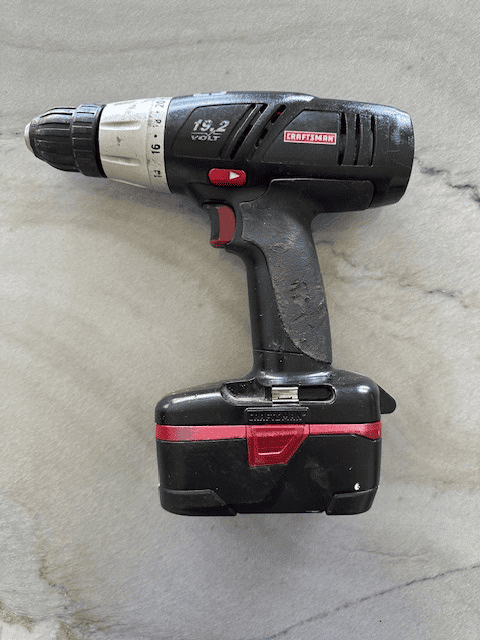A drill is one of the most useful tools for DIY projects. They are commonly used to bore holes into various materials such as wood, metal, plastic and masonry. There are different types of drills and you may need different ones depending on the project.
History
The history of the drill spans from ancient times when early humans used simple hand tools to bore holes in materials, to the Middle Ages with devices like the Roman Archimedes screw. The 19th century saw the development of hand-powered drills and, in 1895, the invention of the electric drill by Arthur James, which revolutionized industrial drilling. The 20th century brought major advancements with the introduction of the portable electric drill by Black & Decker in 1917 and the emergence of cordless drills in the 1960s. Today, drills feature advanced battery technology and ergonomic designs, reflecting significant technological progress from their early origins.
Types of Drills
- Cordless Drill – The most common drill used today. Operates off a rechargeable battery allowing use in many different locations.
- Corded Drill – Provides continuous power and useful when you need a powerful drill. Does require access to a power outlet in the vicinity of your DIY project.
- Hammer Drill – Provides a hammering action while drilling which is ideal for use on concrete or stone.
- Impact Driver – A type of specialty drill used for driving in screws. Commonly used along side a drill where you need to drill a pilot hole followed by driving in a screw.
- Drill Press – Fixed-style drill that is used to drill precise holes. Provides greater accuracy than handheld drills.

Features of a Drill
Power Source:
- Corded: Provides continuous power for prolonged use.
- Cordless: Offers mobility and convenience with rechargeable batteries.
Voltage/Amps:
- Determines the power and suitability for different tasks.
- Higher voltage/amps for more demanding applications.
Speed Settings:
- Variable speed control for precision and versatility.
- Multiple speed options for different materials and tasks.
Torque Settings:
- Adjustable torque to prevent overdriving or stripping screws.
- Higher torque for tougher materials.
Chuck Type:
- Keyless chuck for quick and easy bit changes.
- Keyed chuck for a more secure grip on the drill bit.
Drill Modes:
- Drilling mode for general drilling tasks.
- Hammer mode for drilling into concrete and masonry.
- Screwdriver mode for driving screws.
Ergonomics:
- Comfortable grip and balanced design for extended use.
- Lightweight construction to reduce user fatigue.
Built-in Features:
- LED lights for improved visibility in low-light conditions.
- Built-in levels for more accurate drilling.
- Belt clips for convenient storage and access.
Battery Life and Type (for cordless drills):
- Lithium-ion batteries for longer life and quick charging.
- Removable batteries for extended usage and easy replacement.
Durability:
- Robust construction to withstand tough job site conditions.
- High-quality materials for long-lasting performance.
Accessories:
- Compatibility with various drill bits and attachments.
- Included cases or storage solutions for organization and portability.
Choosing the Right Drill
Choosing the right drill involves considering several key factors to match your specific needs. First, decide between a corded or cordless drill based on your mobility requirements and the power needed for your tasks. Corded drills offer continuous power but limit mobility, while cordless drills provide convenience and portability with varying battery life. Next, evaluate the drill’s power, measured in volts for cordless models or amps for corded ones, to ensure it meets the demands of your projects. The drill’s speed and torque settings are also crucial; variable speed settings allow for greater control over different materials, while adjustable torque helps prevent overdriving screws. Additionally, consider the drill’s weight and ergonomics for comfort during extended use. Finally, check for additional features like LED lights and built-in levels, which can enhance functionality. By assessing these factors, you can select a drill that best suits your needs and ensures efficient and effective performance for your projects.
Proper Use and Techniques
Proper use and techniques are essential for maximizing the efficiency and safety of your drill. Begin by selecting the appropriate drill bit for the material you’re working with and ensure it is securely attached before starting. When drilling, hold the drill firmly with both hands, keeping a stable stance to prevent slipping or wobbling. Start with a slow speed to create a pilot hole, then increase speed as needed for deeper drilling. Apply steady, even pressure without forcing the drill, as excessive force can damage the bit or the material. For accurate results, use a drill guide or clamp to stabilize the workpiece. Always wear safety gear, such as safety glasses and ear protection, to guard against debris and noise. Regularly check and maintain your drill to keep it in good working condition, and follow the manufacturer’s instructions for specific operational and safety guidelines. Adhering to these practices ensures precise, efficient drilling and reduces the risk of accidents or damage.
Maintenance and Care
Proper maintenance and care are vital for extending the lifespan and performance of your drill. Start by regularly cleaning the drill after use to remove dust, debris, and residue that can affect its functionality. For corded drills, ensure the power cord is in good condition and avoid using it if it shows signs of wear or damage. For cordless drills, keep the battery contacts clean and store batteries in a cool, dry place to prevent degradation. Check the drill bits frequently for signs of wear or dullness, and replace them as needed to ensure optimal performance. Lubricate the drill’s moving parts periodically according to the manufacturer’s recommendations to keep them functioning smoothly. Ensure the chuck is properly tightened to prevent bits from slipping during use, and regularly inspect it for any damage or malfunction. Finally, store your drill in a clean, dry environment to protect it from moisture and extreme temperatures. Following these maintenance practices will help keep your drill in excellent working condition and ready for any project.
Safety Tips
Ensuring safety while using a drill is crucial to prevent accidents and injuries. Always wear appropriate personal protective equipment (PPE), such as safety goggles, gloves, and ear protection, to shield yourself from debris, dust, and noise. Before starting, inspect the drill and drill bits for any damage or defects and ensure they are securely attached. Keep your work area clean and well-lit to avoid tripping hazards and improve visibility. When operating the drill, maintain a firm grip and a stable stance to prevent slipping or losing control. Avoid drilling near electrical wiring or pipes to prevent accidental damage or injury. Use the drill’s safety features, such as the clutch or variable speed settings, to control the drill’s power and prevent overdriving or stripping screws. Always follow the manufacturer’s instructions and safety guidelines specific to your drill model. After use, unplug corded drills or remove the battery from cordless drills to ensure they are safe to handle and store. By adhering to these safety tips, you can protect yourself and others while ensuring a successful and safe drilling experience.
Drill Recommendations
The following are some recommendations on drills:
Drill Accessories
- Chuck Key – Used with many corded drills for securing the drill bit.
- Drill Bits – Main accessory for drills and comes in many different sizes and types.
- Screwdriver Bits – Can be used with drills but mostly used with impact drivers.
Conclusion
In conclusion, selecting the right drill, using it with proper techniques, and adhering to maintenance and safety practices are essential for effective and safe drilling. By understanding the historical advancements of drills and applying careful consideration to your choice of tool, you can enhance your DIY projects and ensure optimal performance. Regular maintenance and adherence to safety protocols not only prolong the life of your drill but also safeguard against potential hazards, allowing you to work confidently and efficiently.


